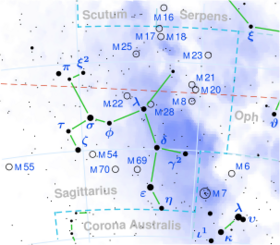Astronomy:21 Sagittarii
| Observation data Equinox J2000.0]] (ICRS) | |
|---|---|
| Constellation | Sagittarius |
| Right ascension | 18h 25m 21.04075s[1] |
| Declination | −20° 32′ 30.0385″[1] |
| Apparent magnitude (V) | 4.81[2] (5.03 + 7.43)[3] |
| Characteristics | |
| Spectral type | K2II + A5:[4][3] |
| U−B color index | +0.93[5] |
| B−V color index | +1.30[5] |
| Astrometry | |
| Radial velocity (Rv) | −11.80[6] km/s |
| Proper motion (μ) | RA: +8.46[1] mas/yr Dec.: −28.07[1] mas/yr |
| Parallax (π) | 7.95 ± 0.72[1] mas |
| Distance | 410 ± 40 ly (130 ± 10 pc) |
| Absolute magnitude (MV) | −0.67[2] |
| Details | |
| 21 Sgr A | |
| Mass | 7.9[7] M☉ |
| Luminosity | 320[2] L☉ |
| Temperature | 4,234[8] K |
| Rotational velocity (v sin i) | 4.4[9] km/s |
| Other designations | |
| Database references | |
| SIMBAD | data |
21 Sagittarii is a binary star[3] system in the southern zodiac constellation of Sagittarius. It is visible to the naked eye as a faint point of light with a combined apparent visual magnitude of 4.81.[2] The system is located approximately 410 light years away from the Sun based on parallax.[1] It is moving closer to the Earth with a heliocentric radial velocity of −11.80 km/s.[6]
As of 2008, the pair had an angular separation of 1.7″ along a position angle of 280°. The brighter member of the pair, designated component A, is a K-type bright giant with a stellar classification of K2II[4] and visual magnitude 5.03.[3] It has eight[7] times the mass of the Sun and is radiating 320[2] times the Sun's luminosity from its photosphere at an effective temperature of 4,234 K[8] Its companion, component B, is magnitude 7.43 with type reported as A5:, where the ':' indicates some uncertainty about the classification.[11][3]
In Fiction
The BBC science docu-drama "First Contact: An Alien Encounter" first shown in 2022 imagined how the world would react if it made contact with aliens. In the drama, an extra terrestrial artefact was said to originated from 21 Sagittarii.
References
- ↑ 1.0 1.1 1.2 1.3 1.4 1.5 Van Leeuwen, F. (2007). "Validation of the new Hipparcos reduction". Astronomy and Astrophysics 474 (2): 653–664. doi:10.1051/0004-6361:20078357. Bibcode: 2007A&A...474..653V. Vizier catalog entry
- ↑ 2.0 2.1 2.2 2.3 2.4 Anderson, E.; Francis, Ch. (2012). "XHIP: An extended hipparcos compilation". Astronomy Letters 38 (5): 331. doi:10.1134/S1063773712050015. Bibcode: 2012AstL...38..331A. Vizier catalog entry
- ↑ 3.0 3.1 3.2 3.3 3.4 Eggleton, P. P.; Tokovinin, A. A. (2008). "A catalogue of multiplicity among bright stellar systems". Monthly Notices of the Royal Astronomical Society 389 (2): 869. doi:10.1111/j.1365-2966.2008.13596.x. Bibcode: 2008MNRAS.389..869E. Vizier catalog entry
- ↑ 4.0 4.1 Hoffleit, D.; Warren, W. H. (1995). "VizieR Online Data Catalog: Bright Star Catalogue, 5th Revised Ed. (Hoffleit+, 1991)". VizieR On-line Data Catalog: V/50. Originally Published in: 1964BS....C......0H 5050. Bibcode: 1995yCat.5050....0H.
- ↑ 5.0 5.1 Mallama, A. (2014). "Sloan Magnitudes for the Brightest Stars". The Journal of the American Association of Variable Star Observers 42 (2): 443. Bibcode: 2014JAVSO..42..443M.Vizier catalog entry
- ↑ 6.0 6.1 Gontcharov, G. A. (2006). "Pulkovo Compilation of Radial Velocities for 35 495 Hipparcos stars in a common system". Astronomy Letters 32 (11): 759–771. doi:10.1134/S1063773706110065. Bibcode: 2006AstL...32..759G.
- ↑ 7.0 7.1 Tetzlaff, N.; Neuhäuser, R.; Hohle, M. M. (2011). "A catalogue of young runaway Hipparcos stars within 3 kpc from the Sun". Monthly Notices of the Royal Astronomical Society 410 (1): 190–200. doi:10.1111/j.1365-2966.2010.17434.x. Bibcode: 2011MNRAS.410..190T. Vizier catalog entry
- ↑ 8.0 8.1 McDonald, I.; Zijlstra, A. A.; Boyer, M. L. (2012). "Fundamental parameters and infrared excesses of Hipparcos stars". Monthly Notices of the Royal Astronomical Society 427 (1): 343–357. doi:10.1111/j.1365-2966.2012.21873.x. Bibcode: 2012MNRAS.427..343M. Vizier catalog entry
- ↑ Glebocki, R.; Gnacinski, P. (2005). "VizieR Online Data Catalog: Catalog of Stellar Rotational Velocities (Glebocki+ 2005)". VizieR On-line Data Catalog: III/244. Originally Published in: 2005csss...13..571G; 2005yCat.3244....0G 3244. Bibcode: 2005yCat.3244....0G. Vizier catalog entry
- ↑ "21 Sgr". SIMBAD. Centre de données astronomiques de Strasbourg. http://simbad.u-strasbg.fr/simbad/sim-basic?Ident=21+Sgr.
- ↑ Mason, Brian D.; Wycoff, Gary L.; Hartkopf, William I.; Douglass, Geoffrey G.; Worley, Charles E. (2001). "The 2001 US Naval Observatory Double Star CD-ROM. I. The Washington Double Star Catalog". The Astronomical Journal 122 (6): 3466. doi:10.1086/323920. Bibcode: 2001AJ....122.3466M. Vizier catalog entry
 |


